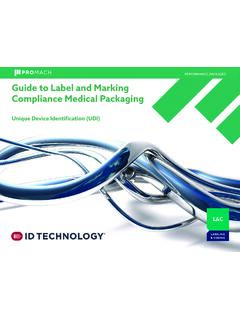Transcription of Healthcare Implementation Guideline: Applying GS1 ...
1 Healthcare Implementation Guideline: Applying GS1 Standards for DSCSA and Traceability Release , Nov 07 2016 Implementation Guideline: Applying GS1 Standards for DSCSA and Traceability NOV 07 2016 2016 GS1 US ALL RIGHTS RESERVED Page 2 of 126 Table of Contents Part I: Foundational Concepts .. 8 1 Preface .. 9 Introduction .. 9 Document Information .. 10 Contributors .. 10 Purpose .. 11 Future Releases .. 12 Scope .. 12 Normative References .. 12 Non-Normative 12 Additional Considerations & Resources .. 13 The GS1 US DSCSA Implementation 13 Summary of Changes from Release 13 Changes to EPCIS Event Specifications for Lot-Level Management .. 14 Changes to EPCIS Event Specifications for Serialized Item Traceability .. 14 Changes to Master Data Element Names and Namespace.
2 16 2 Application to the Drug Supply Chain Security Act (DSCSA) .. 17 EPCIS Approach to DSCSA Phase 1: Lot-Level Management .. 17 GS1 Standards for DSCSA Phase 2: Item-Level Identification & Marking .. 18 EPCIS Approach to DSCSA Phase 3: Item-Level Traceability .. 18 Industry Transitions to DSCSA .. 18 Lot-Level Management & Serialized Item-Level Traceability .. 19 3 Overview of the GS1 Standards Used .. 21 global Location Number (GLN) .. 21 global Trade Item Number (GTIN) .. 21 Serial Shipping Container Code (SSCC) .. 21 GS1 Data Carriers .. 21 GS1 Application Identifiers .. 21 EPC Information Services (EPCIS) .. 22 Core Business Vocabulary (CBV) .. 22 GS1 US DataHub Location .. 22 global Data Synchronization Network (GDSN) .. 22 4 Background Concepts.
3 23 Relationship between NDC GTIN SGTIN .. 23 NDC Labeler Code & GS1 Company Prefix .. 23 Integrating NDCs into GTINs .. 24 GTIN-12 vs. GTIN-14 vs. GTIN-12 in 14-digit format .. 24 Implementation Guideline: Applying GS1 Standards for DSCSA and Traceability NOV 07 2016 2016 GS1 US ALL RIGHTS RESERVED Page 3 of 126 Assigning vs. Storing vs. Encoding GTINs .. 25 Marking Products with Both UPC-A and GS1 DataMatrix .. 25 Case Identification .. 26 Location Identification: Data Capture vs. Data 26 EPCIS & the URI .. 26 Determining the Length of GS1 Company Prefixes for URIs .. 27 Inference .. 27 5 Identify .. 28 Identifying Trade Units (Products, Cases & Kits): GTIN .. 28 Assigning GTINs .. 28 Creating a GTIN-12 .. 29 Creating a GTIN-14.
4 30 Data Format for Databases & Applications .. 31 Data Format for EPCIS .. 31 Batch / Lot Numbers .. 31 Assigning Batch/Lot Numbers .. 31 Data Formats for Databases & Applications .. 31 Data Format for EPCIS: LGTIN URI .. 31 Data Storage Options for GTIN + Batch/Lot Number .. 33 Serial Numbers .. 34 Assigning Serial Numbers .. 34 Data Format for Databases & Applications .. 34 Data Format for EPCIS: SGTIN URI .. 35 Data Storage Options for GTIN + Serial Number .. 37 Identifying Logistics Units (Cases, Pallets & Totes): SSCC .. 38 Assigning SSCCs .. 38 Data Format for Databases .. 38 Data Format for EPCIS: SSCC URI Format .. 39 Data Storage Options .. 40 Identifying Parties & Locations: GLN .. 41 Assigning GLNs .. 41 Assigning GLN Extensions.
5 41 Data Format for Databases .. 42 Data Format for EPCIS: SGLN URI Format .. 42 Data Storage Options .. 43 Alternate Party Identifier: DEA Number .. 44 6 Capture .. 45 Encoding GS1 Data Carriers .. 45 Barcodes .. 45 Trade Items: Products, Cases & 47 Encoding Principles .. 47 Examples .. 48 Implementation Guideline: Applying GS1 Standards for DSCSA and Traceability NOV 07 2016 2016 GS1 US ALL RIGHTS RESERVED Page 4 of 126 Marking Products with Both UPC-A and GS1 DataMatrix .. 48 Rules for Expressing Expiration Date .. 49 Logistics Units: Pallets, Cases & Totes .. 50 EPC/RFID Tags .. 51 Translating Captured Data .. 51 GTIN + Batch/Lot Number .. 52 EPC URI Format .. 52 Data Storage Options for GTIN + Batch/Lot Number .. 53 GTIN + Serial Number.
6 53 EPC URI Format .. 53 Data Storage Options for GTIN + Serial Number .. 55 SSCC .. 55 EPC URI Format .. 55 Data Storage Options .. 56 7 Share Concepts .. 57 Master 57 Event Data .. 58 8 EPCIS Principles for this 60 Master Data in EPCIS Events for DSCSA .. 60 Data Rules for this 60 EPCIS Event Time .. 60 EPCIS Read Points and Business Locations .. 62 EPCIS Business Transactions .. 62 EPCIS Expiration Date .. 63 Checking EPCIS Event Contents .. 63 EPCIS Extension Elements .. 63 Core Business Vocabulary (CBV) Extensions .. 64 EPCIS Event Fields .. 64 Part II: Application of EPCIS for Lot-Level Management .. 65 9 Overview of Lot-Level Management .. 66 10 DSCSA Lot-Level Data Elements .. 67 11 EPCIS Events for Lot-Level Management.
7 68 Shipping Event .. 68 Populating a Shipping Event for Lot-Level Management .. 68 Shipping Event Extension for Lot-Level Management .. 69 EPCIS Header Extensions for Shipping Events for Lot-Level Management .. 70 EPCIS Header Master Data for Lot-Level Management .. 70 Trade Item Master Data .. 71 Implementation Guideline: Applying GS1 Standards for DSCSA and Traceability NOV 07 2016 2016 GS1 US ALL RIGHTS RESERVED Page 5 of 126 Company Master Data .. 71 Production Lot Master Data .. 72 Shipping Event Example XML .. 72 Transformation Event for Repackaging .. 75 Transformation Event Example XML .. 76 Part III. Application of EPCIS for Serialized Item-Level Traceability .. 81 12 Overview of Serialized Item-Level Traceability Concepts .. 82 Events Captured and Shared by the Party at the Beginning of the Supply Chain.
8 82 Events Captured and Shared by Intermediate Parties .. 82 Events Captured and Shared by the Party at the End of the Supply Chain .. 82 Events Captured and Shared by a Party for Exception Processing .. 83 13 DSCSA Item-Level Data Elements .. 84 14 EPCIS Events for Serialized Item-Level Traceability .. 85 Commissioning .. 85 Populating a Commissioning Event .. 85 Commissioning Event Instance/Lot Master Data (ILMD) Attributes .. 86 Commissioning Event Master Data .. 86 Commissioning Object Event 87 XML Example of a Commissioning Event .. 87 Packing .. 89 Populating a Packing Event .. 89 XML Example of a Packing Event .. 89 Shipping .. 91 Populating a Shipping Event .. 91 Shipping Event Extension .. 93 Shipping Event Master Data .. 94 XML Example of a Shipping Event.
9 95 Shipping Business Transaction Detail Event .. 96 XML Example of a Shipping Business Transaction Detail Event .. 97 XML Example of a Shipment Covered by Multiple Purchase Orders .. 98 Receiving .. 101 Populating a Receiving Event .. 101 Receiving Event Master Data .. 103 XML Example of a Receiving Event .. 103 Unpacking .. 105 Populating an Unpacking Event .. 105 XML Example of an Unpacking Event .. 106 Dispensing .. 107 Populating a Dispensing Event .. 107 XML Example of a Dispensing Event .. 107 Implementation Guideline: Applying GS1 Standards for DSCSA and Traceability NOV 07 2016 2016 GS1 US ALL RIGHTS RESERVED Page 6 of 126 Destroying .. 109 Populating a Destroying Event .. 109 XML Example of a Destroying Event .. 109 Decommissioning.
10 111 Populating a Decommissioning 111 XML Example of a Decommissioning Event .. 111 Void Shipping .. 113 Populating a Void Shipping Event .. 113 Void Shipping Event Master Data .. 115 XML Example of a Void Shipping Event (entire shipment cancellation) .. 115 XML Example of a Void Shipping Event (partial shipment cancellation) .. 116 EPCIS Error Declaration Mechanism .. 119 A Appendix: Converting an 11-digit NDC to a 10-digit NDC .. 122 B Appendix: GS1 Standards .. 123 C Appendix: Acronyms .. 124 Implementation Guideline: Applying GS1 Standards for DSCSA and Traceability NOV 07 2016 2016 GS1 US ALL RIGHTS RESERVED Page 7 of 126 About GS1 GS1 is a neutral, not-for-profit, global organization that develops and maintains the most widely-used supply chain standards system in the world.



















